The Minimally Invasive Spine Technologies Market is estimated to be valued at USD 1.5 billion in 2025 and is projected to reach USD 2.4 billion by 2035, registering a compound annual growth rate (CAGR) of 5.1% over the forecast period.
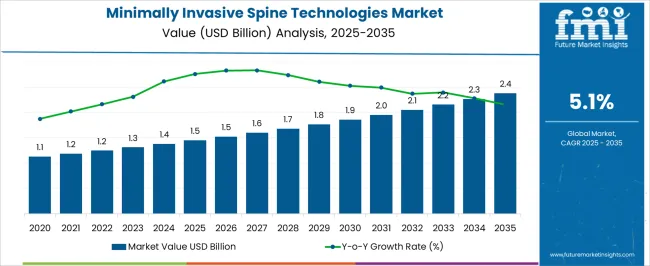
| Metric | Value |
|---|---|
| Minimally Invasive Spine Technologies Market Estimated Value in (2025 E) | USD 1.5 billion |
| Minimally Invasive Spine Technologies Market Forecast Value in (2035 F) | USD 2.4 billion |
| Forecast CAGR (2025 to 2035) | 5.1% |
The Minimally Invasive Spine Technologies market is experiencing strong growth, driven by increasing prevalence of spinal disorders, rising geriatric population, and growing preference for procedures that reduce recovery time and surgical complications. Advancements in minimally invasive techniques, surgical tools, and image-guided navigation systems are enhancing precision and improving patient outcomes. Hospitals and specialized clinics are increasingly adopting these technologies to meet demand for safer, faster, and more cost-effective spinal treatments.
Benefits such as reduced blood loss, smaller incisions, shorter hospital stays, and accelerated rehabilitation are contributing to adoption across both developed and emerging markets. Regulatory approvals and clinical evidence supporting efficacy are further reinforcing confidence among healthcare providers.
Additionally, growing awareness among patients regarding less invasive alternatives and faster recovery timelines is influencing treatment preferences Integration with robotics, intraoperative imaging, and real-time monitoring is expected to drive innovation and expand applications, positioning the market for continued long-term growth across clinical and surgical settings.
The minimally invasive spine technologies market is segmented by technique type, treatment, end user, and geographic regions. By technique type, minimally invasive spine technologies market is divided into Percutaneous Pedicle Screw-Rod Fixation, Translaminar And Transfacet Screws, Transsacral Fixation, and Cervical Fixation. In terms of treatment, minimally invasive spine technologies market is classified into Degenerative Disc Disease, Herniated Disc, Lumbar Spinal Stenosis, Spinal Deformities Such As Scoliosis, Spinal Infections And Instability, Spinal Tumors, and Vertebral Compression Fractures. Based on end user, minimally invasive spine technologies market is segmented into Hospitals, Orthopedic Clinics, and Ambulatory Surgical Centers. Regionally, the minimally invasive spine technologies industry is classified into North America, Latin America, Western Europe, Eastern Europe, Balkan & Baltic Countries, Russia & Belarus, Central Asia, East Asia, South Asia & Pacific, and the Middle East & Africa.
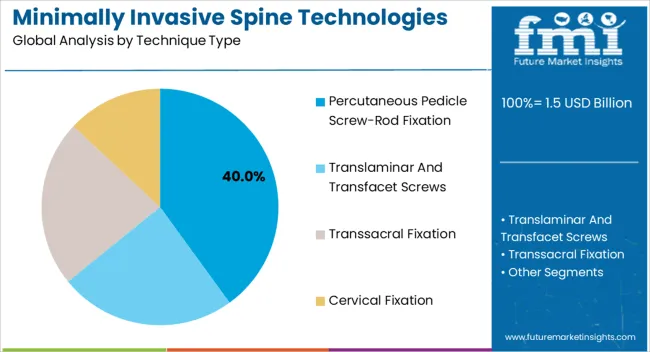
The percutaneous pedicle screw-rod fixation segment is projected to hold 40.0% of the market revenue in 2025, establishing it as the leading technique type. Growth is being driven by its ability to provide spinal stabilization with minimal tissue disruption, reduced operative trauma, and improved recovery outcomes. The technique allows precise screw placement using advanced imaging and navigation systems, reducing the risk of complications and enhancing surgical accuracy.
Its applicability in various spinal disorders, including degenerative, traumatic, and deformity cases, supports widespread adoption. Hospitals and spine centers are increasingly leveraging this technique to meet the demand for less invasive yet effective surgical interventions.
Cost efficiency achieved through reduced hospital stays and faster rehabilitation timelines further strengthens preference As technological innovations in navigation, instrumentation, and intraoperative monitoring continue, the percutaneous pedicle screw-rod fixation segment is expected to maintain its leadership, supported by proven clinical outcomes and growing surgeon expertise.
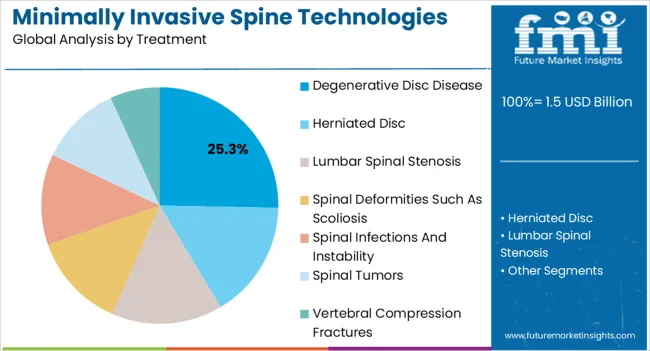
The degenerative disc disease treatment segment is anticipated to account for 25.3% of the market revenue in 2025, making it the leading treatment application. Growth is being driven by the rising incidence of age-related spinal degeneration and associated chronic pain conditions, which are increasing demand for effective minimally invasive solutions. Surgical interventions are increasingly preferred over conservative treatments for patients with severe symptoms, providing better pain relief and functional improvement.
Advanced minimally invasive techniques allow targeted decompression and stabilization with reduced tissue damage, promoting faster recovery and minimizing postoperative complications. Awareness among patients and referring physicians regarding the benefits of minimally invasive spine technologies has further accelerated adoption.
Additionally, integration with advanced imaging, navigation, and robotic-assisted tools improves procedural precision and success rates As healthcare providers continue to prioritize improved patient outcomes, reduced hospital stays, and optimized surgical efficiency, degenerative disc disease treatments are expected to remain a primary driver of market growth.
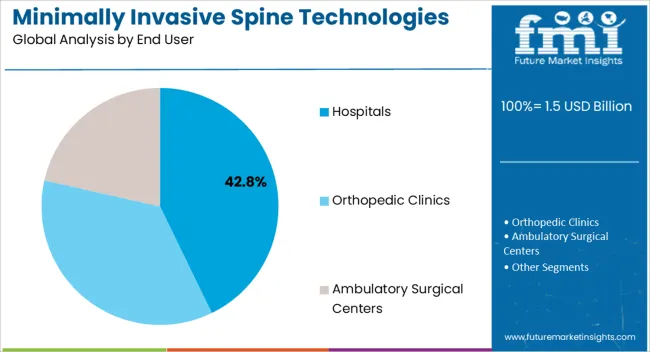
The hospitals end-use segment is projected to hold 42.8% of the market revenue in 2025, establishing it as the leading end-use category. Growth in this segment is driven by the need for advanced surgical infrastructure, skilled personnel, and high patient volumes to perform minimally invasive spine procedures efficiently. Hospitals are increasingly investing in state-of-the-art operating theaters, navigation systems, imaging equipment, and robotic assistance to provide high-precision spine surgeries.
The ability to deliver reduced recovery times, shorter hospital stays, and improved clinical outcomes makes these technologies highly attractive for both surgeons and patients. Training programs, clinical evidence, and surgeon expertise are further supporting adoption.
Large hospitals and specialty spine centers are also able to manage a wider range of complex cases, enabling economies of scale and improving overall procedural efficiency With increasing patient demand for less invasive interventions and greater institutional focus on quality of care, the hospital segment is expected to remain the primary contributor to market revenue and growth.
Minimally invasive spinal technologies are used to treat the spinal disorders. Minimal invasive spinal surgeries are gaining importance over the years owing to their benefits minimal incisions on the body, avoids damage to the spinal muscles, fewer pain conditions, and speedy recovery. Minimally invasive spinal surgery is also called as less invasive spinal surgery.
Minimally invasive surgery procedures are commonly are preferred when medication therapy and physical treatments were not successful in treating the back pain conditions. To treat back pain conditions, the physician has to make long incisions on the body, and they have to move the muscles to the side to access the spine to treat spinal conditions.
The major drawbacks of the open surgery are by pulling the muscles during the operation it will create pressure on the surrounding muscles. In some instances, it causes muscle injury due to that patients might feel pain after the surgery and leads to lengthy recovery. To overcome the problems above minimally, invasive spinal surgeries are performed.
Minimally invasive spinal surgeries will create small incisions on the body, and they will not create much pressure on the spinal muscles and helps in faster recovery. According to the research article, every year around 2,50,000 lumbar spine surgeries are performed in the USA Minimally invasive spine techniques are mostly used to treat lumbar degenerative diseases, fracture, infection, instability, disc herniation and tumors conditions.
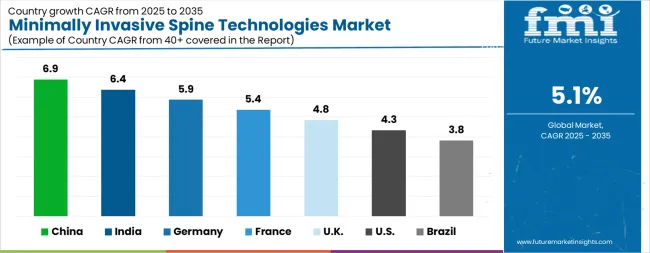
| Country | CAGR |
|---|---|
| China | 6.9% |
| India | 6.4% |
| Germany | 5.9% |
| France | 5.4% |
| UK | 4.8% |
| USA | 4.3% |
| Brazil | 3.8% |
The Minimally Invasive Spine Technologies Market is expected to register a CAGR of 5.1% during the forecast period, exhibiting varied country level momentum. China leads with the highest CAGR of 6.9%, followed by India at 6.4%. Developed markets such as Germany, France, and the UK continue to expand steadily, while the USA is likely to grow at consistent rates. Brazil posts the lowest CAGR at 3.8%, yet still underscores a broadly positive trajectory for the global Minimally Invasive Spine Technologies Market. In 2024, Germany held a dominant revenue in the Western Europe market and is expected to grow with a CAGR of 5.9%. The USA Minimally Invasive Spine Technologies Market is estimated to be valued at USD 540.1 million in 2025 and is anticipated to reach a valuation of USD 825.6 million by 2035. Sales are projected to rise at a CAGR of 4.3% over the forecast period between 2025 and 2035. While Japan and South Korea markets are estimated to be valued at USD 66.1 million and USD 43.7 million respectively in 2025.
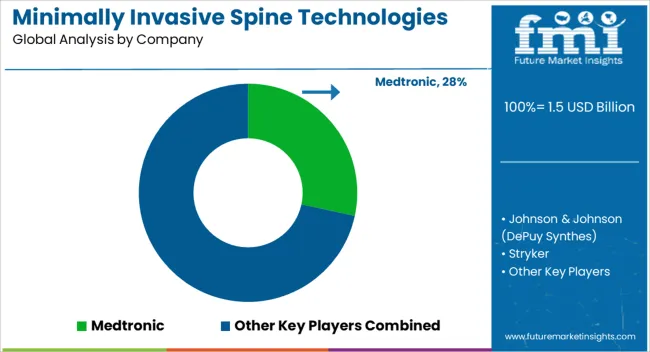
| Item | Value |
|---|---|
| Quantitative Units | USD 1.5 Billion |
| Technique Type | Percutaneous Pedicle Screw-Rod Fixation, Translaminar And Transfacet Screws, Transsacral Fixation, and Cervical Fixation |
| Treatment | Degenerative Disc Disease, Herniated Disc, Lumbar Spinal Stenosis, Spinal Deformities Such As Scoliosis, Spinal Infections And Instability, Spinal Tumors, and Vertebral Compression Fractures |
| End User | Hospitals, Orthopedic Clinics, and Ambulatory Surgical Centers |
| Regions Covered | North America, Europe, Asia-Pacific, Latin America, Middle East & Africa |
| Country Covered | United States, Canada, Germany, France, United Kingdom, China, Japan, India, Brazil, South Africa |
| Key Companies Profiled | Medtronic, Johnson & Johnson (DePuy Synthes), Stryker, Zimmer Biomet, and NuVasive |
The global minimally invasive spine technologies market is estimated to be valued at USD 1.5 billion in 2025.
The market size for the minimally invasive spine technologies market is projected to reach USD 2.4 billion by 2035.
The minimally invasive spine technologies market is expected to grow at a 5.1% CAGR between 2025 and 2035.
The key product types in minimally invasive spine technologies market are percutaneous pedicle screw-rod fixation, translaminar and transfacet screws, transsacral fixation and cervical fixation.
In terms of treatment, degenerative disc disease segment to command 25.3% share in the minimally invasive spine technologies market in 2025.
Explore Similar Insights

Thank you!
You will receive an email from our Business Development Manager. Please be sure to check your SPAM/JUNK folder too.
Chat With
MaRIA